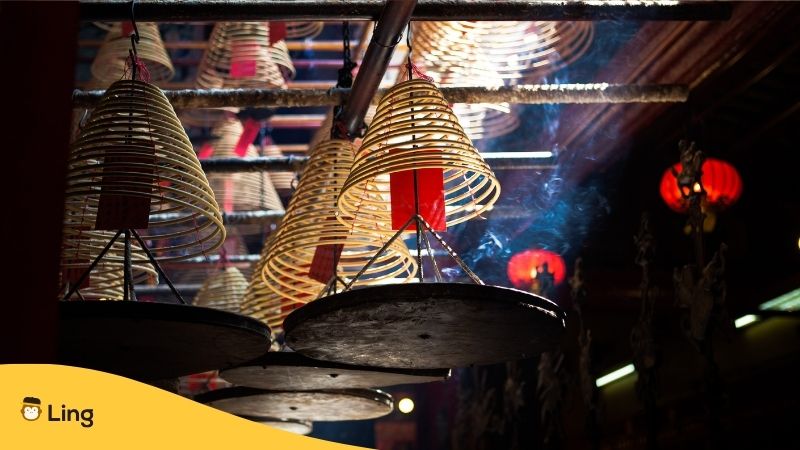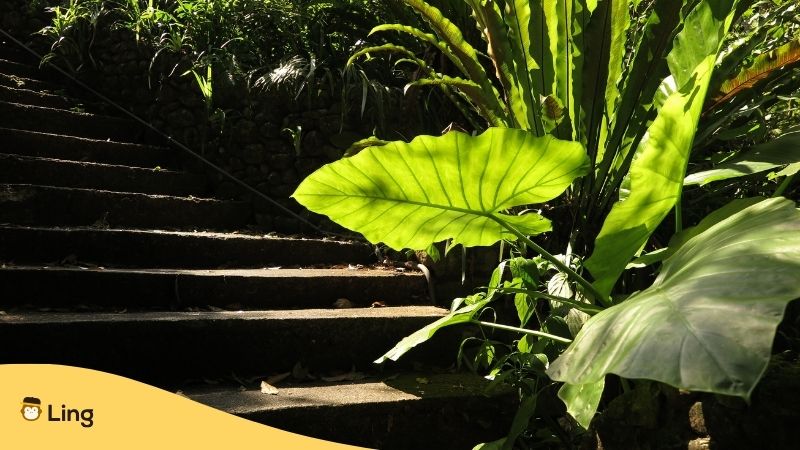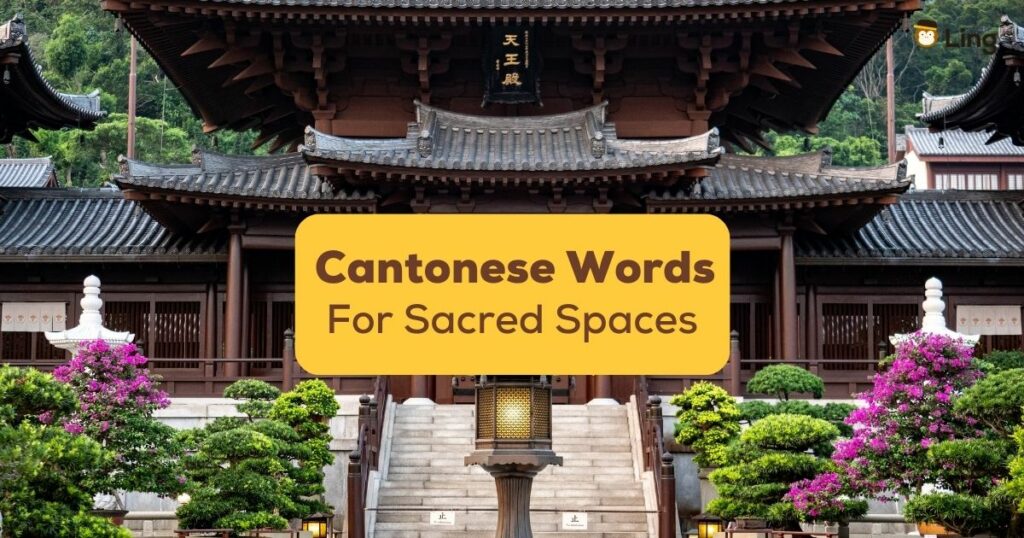Among the skyscrapers, commerce, and hustle of modern-day Hong Kong are peaceful places of refuge where you can take stock before heading back into the hubbub. So, let’s settle back with a cup of cha (茶) and learn Cantonese words for sacred spaces in Hong Kong and Guangdong Province.
These sacred sites offer a glimpse into the spiritual diversity of the region, where Buddhist temples, Taoist traditions, Confucianism, and various beliefs in Chinese folk religion intertwine. As we embark on this cultural journey, we will discover the fascinating world of temples, shrines, and other sacred spaces that hold a special place in the hearts of the local Cantonese people.
Cantonese Words For Sacred Spaces
Let us take a look at the different types of sacred spaces dotting the Cantonese landscape.
Temples – Miàoyǔ (廟宇)
Hong Kong is packed with temples, and here are three of the best.
Wong Tai Sin Temple – Huáng Dàxiān Cí (黃大仙祠)
The Wong Tai Sin Temple, located in Kowloon, Hong Kong, is the most famous Taoist temple in the region. Dedicated to Wong Tai Sin, a deity known for his healing powers, this temple is a hub of spiritual activity. The Cantonese words associated with this temple are “Huáng dàxiān cí” (黃大仙, pronounced wong4 daai6 sin1), referring to the deity Wong Tai Sin himself, and “祠” (ci4), which means temple or shrine.
Po Lin Monastery – Bǎo Lián Chán Sì (寶蓮禪寺)
Po Lin Monastery is situated on Lantau Island, Hong Kong, and is famous for its enormous Tian Tan Buddha statue. The Cantonese term “Bǎo lián” (寶蓮, bou2 lin4) means “precious lotus,” symbolizing purity in Buddhism. “Chán sì” (禪寺, sim4 zi6) refers to a Zen monastery, emphasizing the focus on meditation and spiritual practice in Chinese religion.
Tin Hau Temple – Tiānhòu Miào (天后廟)
Tin Hau, the Goddess of the Sea, is revered by many in Hong Kong, particularly fishermen and sailors. Tin Hau Temples can be found in various parts of Hong Kong, including the famous one on Joss House Bay in Sai Kung. “Tiānhòu” (天后, tin1 hau6) translates to “Heavenly Empress,” and “miào” (廟, miu6) means temple, collectively representing a sacred space dedicated to this goddess.

Shrines – Shénkān (神龕)
Within the temples, there are countless shrines. Again, here are just a couple you shouldn’t miss:
Kwan Tai Temple – Guān Dìmiào (關帝廟)
Kwan Tai Temple, often found in both Hong Kong and Guangdong Province, is dedicated to Guan Yu, a revered historical figure known for his loyalty, righteousness, and martial prowess. “Guān dì” (關帝, gwaan1 dai3) refers to Guan Yu, and “miào” (廟, miu6) signifies a temple or shrine. These shrines are places of worship for those seeking protection, courage, and success in Chinese society.
Pak Tai Temple – Běi Dìmiào (北帝廟)
Pak Tai, or the Supreme Emperor of the North, is another deity worshipped in Hong Kong and Guangdong Province. “Běi dì” (北帝, bak1 dai3) means “Northern Emperor,” and “miào” (廟, miu6) designates a temple. Pak Tai Temples are sanctuaries where devotees of Chinese popular religion come to seek protection and guidance from this deity.
Ancestral Halls – Zōngcí (宗祠)
Ancestral halls were the focus point of villages long before Hong Kong became the neon, skyscraping metropolis it is today:
Man Mo Temple – Wén Wǔmiào (文武廟)
The Man Mo Temple, found in various locations across Hong Kong, is a classic example of a traditional temple in the Chinese tradition. It is dedicated to Man Cheong (文昌) and Mo Tai (武帝), deities associated with literature and martial arts, respectively. “文武” (man4 mou5) means “civil and martial,” and “廟” (miu6) signifies temple. Ancestral halls like these serve as places for academic and martial arts practitioners to seek blessings.
Pagodas – Bǎotǎ (寶塔)
Pagodas are dome-shaped religious monuments with spiritual significance often built to house Buddhist relics:
Tsz Shan Monastery – Cí Shānsì (慈山寺)
Tsz Shan Monastery, located in Tai Po, Hong Kong, is known for its majestic bronze Guanyin statue and serene surroundings. “慈山” (ci4 saan1) translates to “compassionate mountain,” emphasizing the monastery’s connection to Buddhist teachings of compassion. “寺” (zi6) denotes a monastery, and “寶塔” (bou2 taap3) means “precious pagoda,” highlighting the significance of this sacred space.
Altars – Tán (壇)
Buddhist altars are erected to hold an image of Buddha Shakyamuni to remind us of the importance of striving for an enlightened state.
Eight Immortals Altar – Bāxiān Tán (八仙壇)
The Eight Immortals Altar is a Taoist shrine that pays homage to the Eight Immortals, mythical figures known for their extraordinary abilities. “Bāxiān” (八仙, baat3 sin1) means “eight immortals,” and “tán” (壇, taan4) signifies an altar. Devotees come here to seek blessings, good fortune, and longevity from the Taoist priests.

Natural Sacred Sites – Zìrán Shèngdì (自然聖地)
It is not just temples and shrines that offer peace and tranquillity, enlightenment is also to be found in nature:
Kadoorie Farm & Botanic Garden – Jiā Dàolǐ Nóngchǎng Jì Zhíwùyuán (嘉道理農場暨植物園)
While not a traditional sacred space, Kadoorie Farm and Botanic Garden in the New Territories, Hong Kong, is a place where nature and spirituality converge. “Jiā dàolǐ” (嘉道理, gaa1 dou6 lei5) refers to the Kadoorie family, who founded the farm, “Nóngchǎng” (農場, nung4 coeng4) means farm, and “Zhíwùyuán” (植物園, zik6 mat6 jyun2) designates a botanical garden. This unique site allows visitors to connect with nature and appreciate the beauty of the environment, making it a sacred space in its own right.
From Chinese temples and shrines to ancestral halls, pagodas, altars, and even natural sacred sites, these places play a vital role in the spiritual and everyday life of the local Cantonese people. Exploring these sacred spaces not only offers a glimpse into the region’s cultural tapestry but also invites visitors to appreciate the spiritual and historical treasures they hold.
Language Enlightenment With Ling
Learning a new language can be a spiritual journey in its own right. As well as the Cantonese language, Ling offers more than 60 other languages. So why not start your linguistic enlightenment today by clicking on Google Play or the App Store?



































































